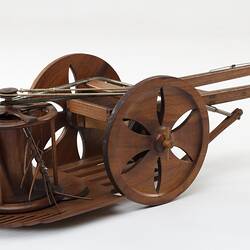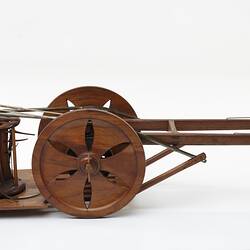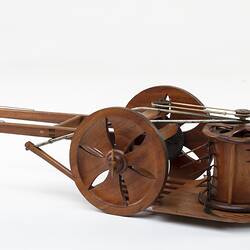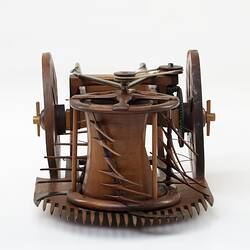Summary
Model of a Push type reaping machine invented and constructed by Mr. R. Savage, Melbourne, Victoria, about 1861. Savage's claim to this invention as an original one is doubtful. A reaper of very similar design (Smith's Reaping Machine of 1811-12) is illustrated in J. C. Louden's Encyclopaedia of Agriculture dated 1844. Cast gears of the model are marked "Peekskill Conklin & Brothers".
The display label that accompanied the model reads: the machine is pushed through the crop by a horse. A bevelled crown wheel attached to one of the carriage wheels operates three sickle-like blades by means of gears and a rope drive. Underneath the front part of the machine are two small supporting wheels on which the machines runs. The comb in front holds the straw while being cut, and it may be raised or lowered by an adjusting lever under each shaft. The blades are fastened to a circular framework supported on three rollers and revolving round a central stationary capstan-shaped drum having a broad longitudinal recess in it. Above each blade is a rake consisting of six pivoted projecting fingers, which, collecting the cut corn and carrying it to the left side, throw off in a bundle. This occurs when the rake trips on reaching movement being aided by a spring wire on each finger. On reaching the other side of the recess, the fingers are automatically put into position again for collecting the cut corn.
Physical Description
Reaper model with two shafts at the front for hitching to a horse. A bevelled crown wheel attached to one of the carriage wheels operates three sickle-like blades by means of gears and a rope drive.
More Information
-
Collecting Areas
-
Acquisition Information
Transfer from National Museum of Victoria, 31 Oct 1871
-
Maker
R. Savage, Melbourne, Greater Melbourne, Victoria, Australia, circa 1861
Makers of cast iron gears on model. -
Past Owner
Peerskill Conklin & Bros
Makers of cast iron gears on model. -
Classification
Agriculture & rural life, Crop management - harvesting, Reapers
-
Category
-
Discipline
-
Type of item
-
Overall Dimensions
1167 mm (Length), 378 mm (Width), 290 mm (Height)
-
Keywords









